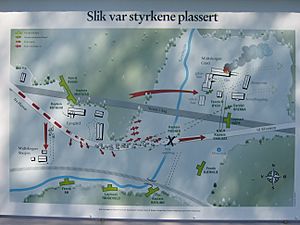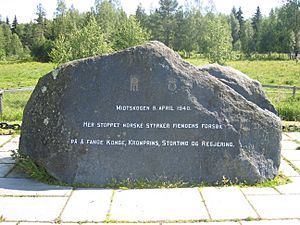Battle of Midtskogen facts for kids
Quick facts for kids Battle of Midtskogen |
|||||||
|---|---|---|---|---|---|---|---|
| Part of Norwegian Campaign of the Second World War | |||||||
 Overview of WW2-battle 10.04.1940 at Midtskogen, Elverum, Norway. |
|||||||
|
|||||||
| Belligerents | |||||||
| Commanders and leaders | |||||||
| Strength | |||||||
|
|
|||||||
| Casualties and losses | |||||||
| 3 wounded | 5 killed unknown number wounded |
||||||
The Battle of Midtskogen was a small but important fight during the Second World War. It happened on the night of April 9–10, 1940. A group of German soldiers tried to capture the King of Norway and his government. But they were stopped by a brave group of Norwegian defenders.
The battle took place at Midtskogen Farm. This farm is about 5 kilometers (3 miles) west of Elverum in southern Norway. The German plan was to force Norway to give up quickly. But after a short fight, the Germans had to retreat. Their commander was even killed during the battle.
Contents
Why the Battle Happened
Germany Invades Norway
On April 9, 1940, Nazi Germany started Operation Weserübung. This was a secret plan to attack and take over both Denmark and Norway.
The Germans thought that if they captured King Haakon VII and the Norwegian government, Norway would surrender right away. They attacked many big Norwegian cities by sea.
The King and Government Escape
The German ships heading for Oslo faced a problem. A Norwegian fortress at Drøbak, called Oscarborg, sank a large German warship named Blücher. This gave the Norwegian royal family and government leaders time to escape. They first went to Hamar, then to Elverum.
A small group of German Fallschirmjäger (paratroopers) was sent after them. These paratroopers were led by a German officer named Eberhard Spiller. They used Norwegian civilian cars they had taken.
Who Fought in the Battle
The Norwegian Defenders
The Norwegian side was made up of different groups. There were about 20-30 Royal Guardsmen. These were professional soldiers. They were joined by volunteers from a military camp called Terningmoen. Many members of local rifle clubs also joined the fight.
The Norwegians mostly used Krag–Jørgensen rifles. They also had two Colt M/29 machine guns.
The German Attackers
The German group had about 100 to 120 paratroopers. They traveled in a convoy of four buses, a captured army truck, and their commander Spiller's car.
Even though the Germans had fewer soldiers, they were much better trained. They also had more powerful weapons. These included many modern submachine guns, light machine guns, and hand grenades.
How the Norwegians Planned to Fight
The Norwegian plan was to set up two roadblocks. One was at Sagstuen, and another a few kilometers west at Midtskogen. They wanted to stop the German convoy at Midtskogen. This would force the Germans to walk through deep snow. Then, the Norwegians would fall back to Sagstuen and hold their ground there.
The two machine guns were supposed to fire at the roadblock. Meanwhile, the rifle soldiers would attack the Germans from the sides.
The Battle Begins
The Roadblock at Midtskogen
The Norwegians made the roadblock at Midtskogen using civilian cars. Some cars were pushed off the road, and others were stuck between them. There was a lot of traffic that night, so the roadblock ended up being over a hundred meters long.
Around 2:00 AM on April 10, the German vehicles crashed into the roadblock. Because the roadblock was so long, the Germans stopped further west than the Norwegians had planned.
The Fight and the Fire
As the Norwegian soldiers tried to move into position, the Germans started firing heavily. During the fight, a nearby barn at Midtskogen farm caught fire. German special rounds, used for lighting up the area, hit the barn. The fire then showed where the Norwegian defenders were hiding.
The Norwegian machine guns were too far away to shoot at the Germans at first. They could only start firing when the Germans moved closer to the roadblock. But because it was so cold, the machine guns didn't work at first. After a lot of effort, the Norwegians got one machine gun working. This helped them cover their retreat.
The fight continued until 3:00 AM. Both sides then pulled back.
German Retreat
The Norwegians gathered again at Sagstuen. More soldiers from the Norwegian Military Academy joined them. The Germans, whose commander Spiller was badly hurt, realized their plan had failed. They decided to retreat back to Oslo.
What Happened After the Battle
The battle didn't cause many deaths or injuries. The Germans had five soldiers killed and an unknown number wounded. Their commander, Eberhard Spiller, was one of those who died. The Norwegians had three soldiers wounded, with at least one seriously hurt.
The German retreat gave the Norwegian government and royal family more time. They were able to complete the Elverum Authorization. This was an important decision that allowed the government to make big choices without the parliament (called the Storting) meeting. It also gave them time to escape even further from the invading German forces.
On April 11, the town of Elverum was heavily bombed by German planes.
Even though the Battle of Midtskogen was a small fight, it was a huge boost for Norwegian spirits. Many Norwegians felt much more hopeful and determined to fight back. This was very important because the Germans had won many early battles in the Norwegian Campaign.
See also
- List of Norwegian military equipment of World War II
- List of German military equipment of World War II
Images for kids




